After 21 years, the iPod has finally come to its end. On May 10, Apple announced that "iPod touch stock is limited and will be sold out" and officially removed the iPod from the product series. In the eyes of some old users, the iPod touch is not an "authentic" iPod, because it is not so much a "music Walkman" as an "iPhone that can't make phone calls".
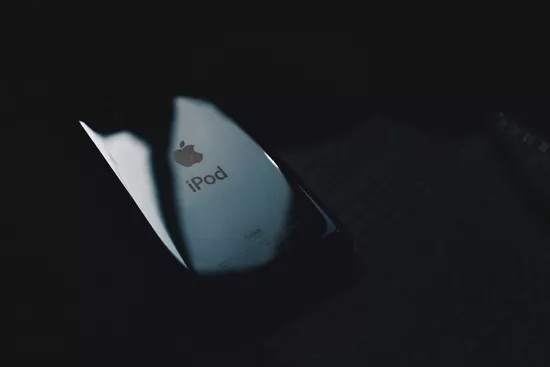

The last generation of iPod touch is also about to sell out
Therefore, there are many opinions on when the iPod era will end: some people think it is 2014, Apple Discontinued iPod classic, and the "orthodox" iPod equipped with a clickwheel no longer exists; Others believe that in 2017, the last generation of iPod Nano and shuffle will be discontinued as the iPod curtain call of "Walkman".
This time, apple itself officially put an end to the era of iPod. In the official press release, apple used a very emotional Title: music is endless.
Legendary beginning
The story of iPod began with an idea of jobs, who wanted to explore a "new field".
In the late 1990s, after tossing about computers for more than 20 years, Steve Jobs, who left apple and returned, wanted to "do something new".
On October 23, 2001, jobs stood on a small indoor stage and announced to the media and audience that Apple would enter the field of "music" and release a "music player".
As for the reason, jobs explained very simply, "we love music, and music is a part of everyone's life." After a series of explanations, he took out the machine called iPod from his pocket and opened the era of iPod.
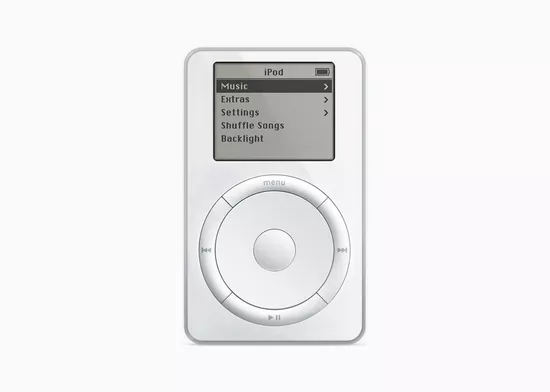
First generation iPod apple
As a "Walkman", the iPod has three "groundbreaking" features.
First, iPod uses "hard disk storage". The first generation iPod was equipped with a mechanical hard disk with a capacity of 5GB, which can hold 1000 songs. This capacity was exaggerated in 2001. The iBook laptop, which is contemporary with the iPod, is only equipped with a 10GB hard disk.
Second, apple designed a "clickwheel" for the iPod. When users browse hundreds of songs stored in the iPod, they don't need to press a button to turn the page all the time, but just turn the turntable with their fingers, and the rotation speed determines the page turning speed. This interactive mode originated from Apple's experience in making notebook touchpad. At that time, it solved the problem of "looking for songs" in Daqu library with great elegance.
Third, the iPod is equipped with Apple's FireWire high-speed interface. Through FireWire, iPod can not only realize the transmission speed 30 times faster than the USB standard at that time, but also realize data transmission and charging at the same time through this interface. This was also a very avant-garde design at that time.
Everything is to achieve one thing: Pocket your entire music library and take it anywhere in the world.
In order to achieve this, the iPod also adopts the song management mode of "synchronization" with the computer. To import a song into your iPod, you must first put the song in iTunes on your computer.
This logic makes many early users in China feel that iPod is "difficult to use" and "troublesome". Unlike many MP3 players, just plug in the computer and drag the files in.
But jobs clearly had his own thinking. In the United States in 2001, most users consumed music by buying CDs. Through iTunes, users can copy the digital music files in the CD into the computer for management. Under this premise, most users' music libraries, including song lists, are actually in iTunes. It is most convenient to plug in an iPod and synchronize with one click.
Moreover, jobs hated "downloading pirated music from the Internet". As he said, the original intention of making iPod was "love music". Therefore, when he makes a player with "hard disk" as the storage medium, what he fears most is that users use the convenience of iPod to listen to pirated music.
So Apple also limits users to syncing songs from the computer to the iPod, but not copying them from the iPod to the computer. Early iPods, on the packaging, would use four national characters to significantly inform users "don't steal music.".
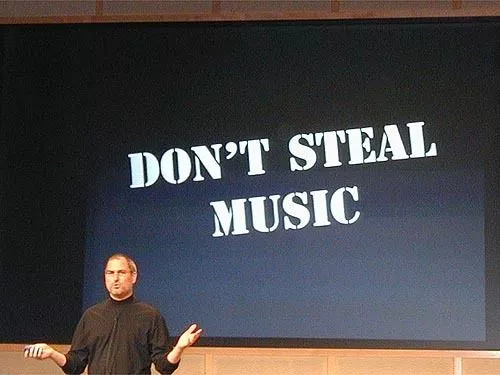
Jobs specially stressed at the press conference of the first generation iPod that he opposed piracy | wired
At that time, apple actually made money only by hardware. Users listened to piracy with iPods, which would not cause any loss to apple, but jobs still insisted on this choice.
After its release, the iPod became popular. After that, based on the original design, Apple has launched a total of six generations of iPods. The last generation released in 2007 is named iPod classic, which is equipped with a maximum 160g hard disk and can hold 40000 songs. It is regarded as a classic by a generation of music fans.
Make your iPod small
After the release of the first generation iPod, apple immediately began to explore one thing that seemed nothing strange at that time, but had a very far-reaching impact: making the iPod small.
Since 2004, Apple has released two generations of iPod mini, seven generations of iPod Nano and four generations of iPod shuffle. Their biggest common ground is "small" and getting smaller and smaller.
Making the iPod small is not a difficult thing to understand: it is a "Walkman". Only the lighter and smaller, the user can carry it more conveniently. Moreover, it was during that time that chip technology developed rapidly, and the performance of iPod became stronger and stronger, with more and more functions.
Starting from the function, Apple will come up with a new design almost every year, such as the 5th generation nano equipped with a rectangular screen to facilitate users to cross over and watch videos; And the 3-generation shuffle, which is extremely small and does not have a button all over the body. Users need to operate by wire through headphones.

Third generation iPod shuffle apple
There have also been some interesting highlights in the process. In 2005, when jobs released the first generation iPod Nano, in order to reflect how small it was, he put it in a "small pocket" above his jeans pocket.
In the early years, this small pocket was originally used to hold pocket watches. Later, the pocket watch became obsolete, but this pocket remained as a classic design, and most people didn't know what it was for. Therefore, when jobs took out the iPod Nano from this small pocket at the press conference, it caused laughter and applause from the audience.
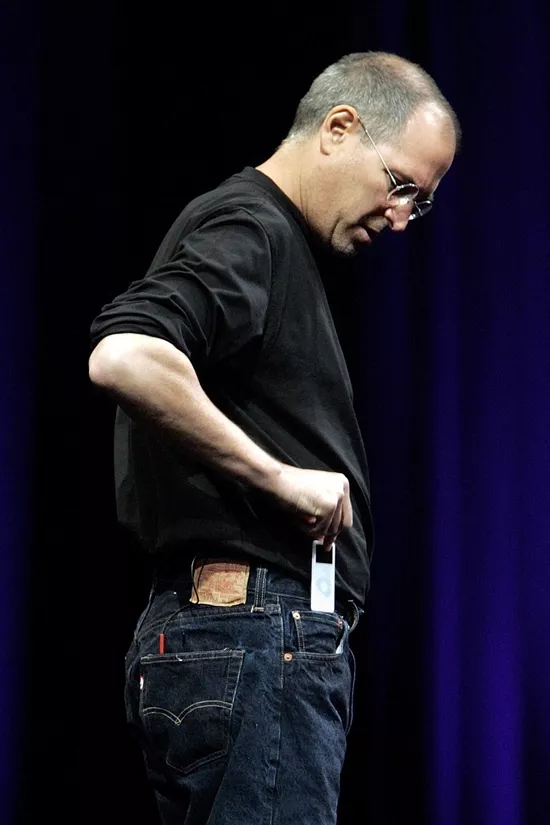
Jobs took out the first generation iPod Nano apple from his jeans pocket
Looking back on this history today, you will find that even apple, which has been criticized for its "invariable" design for many years, is constantly exploring new design and new technology. Technology, product and design are developing rapidly in frequent iterations. IPod mini, nano and shuffle have become the playground for Apple's development team to practice.
This period of history has had a far-reaching impact on the product development after apple.
It can be said that it is precisely because Apple made the iPod and accumulated a series of mobile development experience in making a small motherboard, mobile applications, power supply and storage management in the development process that it developed [iPhone] later( https://apple.pvxt.net/c/1251234/435400/7639?u=https%3A%2F%2Fwww.apple.com%2Fcn%2Fiphone%2F ) Laid the foundation.
Including design and technology, it is also because Apple made an integrated all aluminum shell and metal middle frame on iPod Nano and shuffle, accumulated experience in CNC cutting technology and industry precipitation, and then had the Mac and iPhone with aluminum integrated body.
Even the earliest prototype of Apple watch is based on iPod nano6. The iPod nano6 of that year was equipped with a small square touch screen. Apple also launched a matching watch strap so that users can wear it on their hands.
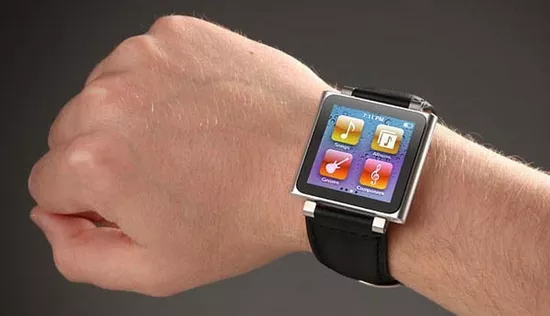
The sixth generation iPod Nano is the design prototype of Apple watch
In 2007, at the iPhone press conference that changed history, jobs stepped onto the stage and said: "today, we are going to release three new products, an iPod, a mobile phone and an Internet communication device". Taken together, these three definitions are iPhone.
IPod and iPhone, both of which are "mobile devices", have a very close relationship, which finally created today's apple. After the iPhone was released that year, considering its relatively high price, Apple quickly launched a product that allows users to "experience the iPhone at a lower cost": iPod touch.
Functionally, the iPod touch is almost an iPhone that can't make a phone call. Because the hardware is highly similar, there was even an "apple skin" that turned iPod touch into iPhone through plug-in communication baseband + cracking system.
It is on the iPod touch that many people feel the charm of "multi touch" and IOS for the first time. It has also become the first stop for many people to "enter apple".
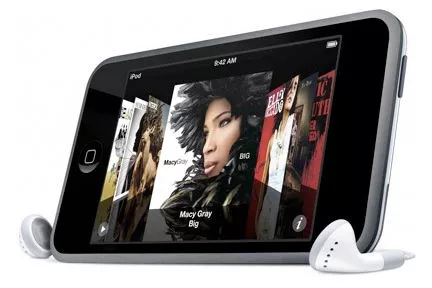
The iPod is so similar to the iPhone that Apple put two earphones on the poster that it emphasized that it was an iPod apple
Fifteen years after its release, the iPod touch has indeed completed its historic mission. Today, if you want to experience the iPhone at a lower cost, there are many options, including iphonese.
So, apple finally put an end to the iPod touch and iPod.
Music is alive and well
With the end of the iPod era, many old users expressed their nostalgia and regret on social media. But anyway, as the title of Apple's press release said: music is endless.
In the summer of 2015, Apple launched Apple music streaming service. Apple music has a very important "icloud music library" function, which provides iPod users with a train leading to the Internet era.
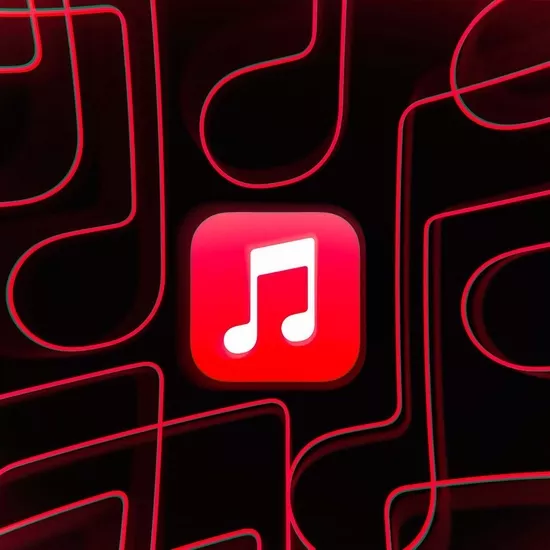
Apple music took the torch from the iPod
Remember the iPod must sync with iTunes's "music library" to import songs? Apple Music's "icloud music library" function can upload your iTunes music library, including all song lists, listening records and scoring, to icloud.
After uploading, all your apple devices are equivalent to a built-in iPod.
You can use iPhone, apple watch and connect to airpods to listen; Working with Mac, iPad , PC listening; You can connect Carplay or car Bluetooth to listen in the car; At home, you can listen on AppleTV and homepod
Since its release, apple music has also been introducing new features. Many function updates are actually similar to the usage of iPod in the early years.
For example, many people will miss their school days and share the experience of music with their friends with an iPod and a headset. On ios14, you can use one iPhone to connect two airpods to achieve a very similar experience; IOS 15 also joined shareplay. You don't need to be in the same place or listen to the same song.
And some people will miss using the analog audio output port of iPod classic to connect a headphone amplifier to listen to HI FI and lossless. Now, apple music is also providing lossless music up to 192Khz.
Of course, iPod symbolizes an era and a specific memory. It plays an indispensable role in our hearts and will not be easily replaced by Apple music. But anyway, if you are still interested in music and are willing to listen to music carefully, they are all there.
Moreover, music has never been limited to Apple's devices and services. In recent years, apple is also opening more system level functions to other companies. For example, you can play spotify with Siri control, and you can also listen to QQ music and Netease cloud on homepod.
As Jobs said in 2001, "music is a part of everyone's life".
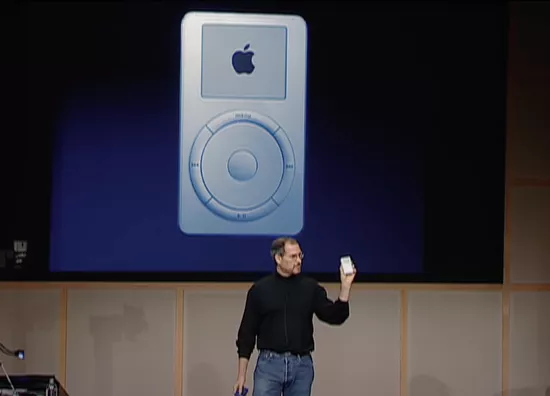
Jobs shows the world the first generation iPod apple
Reviewing the history of the birth and development of pop music, it is not difficult to find that it is an art form deeply bound with technology. Before the birth of pop music, classical music can only be performed on site, which is a scarce product belonging to the top aristocracy of society.
In the 1940s, because of the rise of vinyl records, music began to be copied and spread on a large scale, and pop music was born. After the emergence of pop music, related technologies began to enter a period of great development.
One of the key reasons why jobs wanted to make an iPod was that he liked Sony's Walkman very much; The legendary engineer who invented Walkman, Kenai Da, wanted to make a portable tape walkman in order to listen to his favorite opera records anytime and anywhere.
From gramophone to Walkman, from tape to CD, from iPod to Internet service, generation after generation of people who love music, like Prometheus, the "fire thief", use a torch called technology to transmit music.
From the point of view of "passing on the fire", it is not the end of the iPod. Today, 21 years after its birth, music is more ubiquitous and endless than ever before.
By Jesse
Editor / Jing Yu